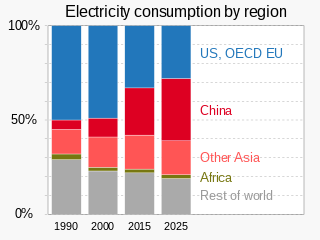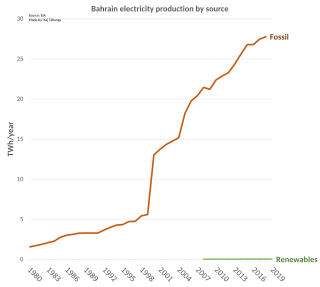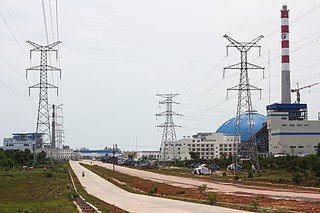Turkmenistan had a total primary energy supply (TPES) of 26.75 Mtoe in 2014. [1] Electricity consumption was 14.64 TWh. Most of this primary energy came from fossil fuels. [1] All of the electricity is generated with natural gas.
Primary energy (PE) is refers to the energy found in nature that has not been subjected to any human engineered conversion process. It encompasses energy contained in raw fuels, and other forms of energy, including waste, received as input to a system. Primary energy can be non-renewable or renewable.

Electric energy consumption is energy consumption in the form of electrical energy. About a fifth of global energy is consumed as electricity: for residential, industrial, commercial, transportation and other purposes. Quickly increasing this share by further electrification is extremely important to limit climate change, because most other energy is consumed by burning fossil fuels thus emitting greenhouse gases which trap heat.

Chile's total primary energy supply (TPES) was 36.10 Mtoe in 2014. Energy in Chile is dominated by fossil fuels, with coal, oil and gas accounting for 73.4% of the total primary energy. Biofuels and waste account for another 20.5% of primary energy supply, with the rest sourced from hydro and other renewables.

The energy mix is a group of different primary energy sources from which secondary energy for direct use - such as electricity - is produced. Energy mix refers to all direct uses of energy, such as transportation and housing, and should not be confused with power generation mix, which refers only to generation of electricity.

Energy in Afghanistan is provided by hydropower followed by fossil fuel and solar power. Currently, less than 50% of Afghanistan's population has access to electricity. This covers the major cities in the country. Many rural areas do not have access to adequate electricity but this should change after the major CASA-1000 project is completed.
Energy in Kuwait describes energy and electricity production, consumption, import and export in Kuwait.

Energy in Algeria describes energy and electricity production, consumption and import in Algeria. Primary energy use in 2009 in Algeria was 462 TWh and 13 TWh per million persons. Algeria is an OPEC country.

Energy policy of Belgium describes the politics of Belgium related to energy. Energy in Belgium describes energy and electricity production. consumption and import in Belgium. Electricity sector in Belgium is the main article of electricity in Belgium.

Energy in the Netherlands describes energy and electricity production, consumption and import in the Netherlands. Electricity sector in the Netherlands is the main article of electricity in the Netherlands.
Electricity in Cyprus is managed by the Electricity Authority of Cyprus. Power is primarily generated at three fuel oil-burning stations but the use of distributed renewable energy is expanding.

Energy in Bahrain describes energy and electricity production, consumption and import in Bahrain. Bahrain is a net energy exporter.

Energy in Yemen describes energy and electricity production, consumption and import in Yemen. Yemen is net energy exporter.

Energy in Belarus describes energy and electricity production, consumption and import in Belarus. Belarus is a net energy importer. According to IEA, the energy import vastly exceeded the energy production in 2015, describing Belarus as one of the world's least energy sufficient countries in the world. Belarus is very dependent on Russia.
Latvia is a net energy importer. Primary energy use in Latvia was 49 TWh, or 22 TWh per million persons in 2009. In 2018, electricity consumption per capita was 3731 kWh.

Primary energy use in Slovakia was 194 TWh and 36 TWh per million inhabitants in 2009.

As of the end of 2022, solar power in Austria amounted to nearly 3.8 gigawatt (GW) of cumulative photovoltaic (PV) capacity, with the energy source producing 4.2% of the nation's electricity.

Cambodia had a total primary energy supply (TPES) of 5.48 Mtoe in 2012. Electricity consumption was 3.06 TWh. About one third of the energy came from oil products and about two thirds from biofuels and waste.

Georgia had a total primary energy supply (TPES) of 4.793 Mtoe in 2016. Electricity consumption was 11.5 TWh in 2016. Electricity production was 11.6 TWh, of which 81% from hydroelectricity and 19% from natural gas.
Uzbekistan had a total primary energy supply (TPES) of 48.28 Mtoe in 2012. Electricity consumption was 47.80 TWh. The majority of primary energy came from fossil fuels, with natural gas, coal and oil the main sources. Hydroelectricity, the only significant renewable source in the country, accounted for about 2% of the primary energy supply. Natural gas is the source for 73.8% of electricity production, followed by hydroelectricity with 21.4%.

World energy supply and consumption is global production and preparation of fuel, generation of electricity, energy transport, and energy consumption. It is a basic part of economic activity. It includes heat, but not energy from food.